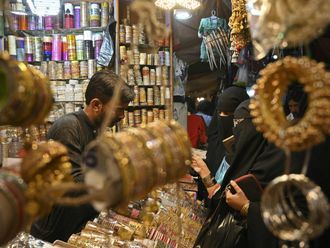Sialkot: Twelve-year-old Adnan Nazir spent three years working, literally, until his fingers bled from hand-stitching footballs that the world's soccer elite prefer.
But on a recent sweltering day, he got to play with one of these balls for the first time in a team of other boys who, like Nazir, were taken from sweatshops where they had worked and enrolled in schools as part of a UN-led project against child labour.
"There was no school in my village so my parents sent me to a factory to stitch balls," Nazir said before kickoff in his game in Sialkot, near Lahore, where 75 per cent of the world's soccer balls are manufactured.
"Life was hard and I hated my work, but now I can go to school and learn," he added.
The United Nations, which held its World Day Against Child Labour yesterday, coaxed Sialkot's football manufacturers into agreeing to ban children from making hand-stitched footballs, which are preferred by the world's leading soccer teams.
Last week, the UN's International Labour Organisation went a step further, launching a Fifa-funded project in Sialkot to form soccer clubs for former child workers, train coaches and equip players.
Registered centres
"All children have the right to play and not be made to work in hazardous workplaces," said Nick Grisewood, a consultant employed by the ILO to create the 'Football Initiative.' Grisewood predicted that the project would be rolled out next year across cricket-crazy Pakistan and other countries to help former child labourers.
Currently, some 170 million children between 9 and 17 work in hazardous environments around the world, according to the United Nations.
In Sialkot, more than 10,000 children have been taken out of stitching centres, where they worked hours each day hunched over a football wedged between their knees while forcing 7.5 centimetre-long needles through thick leather, earning the equivalent of a few cents per ball. Football manufacturers have phased out children working in stitching centres under a 1997 agreement with the ILO and Fifa, football's governing body.
Manufacturers in Sialkot have set up registered stitching centres where no child 14 or under can work.
Major buyers like Adidas and Nike require manufacturers to verify their balls have not been made using child labour.
Despite the success in the football-stitching industry, Pakistan has more to do in curbing child labour in other fields, including agriculture, mining, deep sea fishing, surgical goods manufacturing and brick-making.
About 3 million Pakistani boys and girls between the ages of five and 14 work, about 8 per cent of the country's child population, according to the United Nations.
More than half work in rural areas where few or no child labour eradication projects are in place, particularly in the Punjab and Sindh provinces where children handle pesticides and heavy machinery.
"One of the greatest challenges for us is to break into the rural areas where adults traditionally rely on donkeys or children to work the land," said ILO's Pakistan-based chief technical officer Ahmet Ozirmak.
Improving funding for education, streamlining government bureaucracy and better informing parents about the dangers to children in workplaces is crucial to improving the situation, Ozirmak said.












